Jaguar World March 2022 Twin Test Jekyll & Hyde
TWIN TEST – Jekyll & Hyde
If anything defined the difference in character between the S-TYPE and the XF, it was the supercharged range toppers – at least at first. We compare the very last and first of each and explain why.
BY THE time the XF arrived in late 2007, Jaguar was on the brink of the most seismic change in its history. The replacement for the S-TYPE was a car that would represent a huge change of direction for the marque, even if it was based on essentially the same architecture and offered with similar powertrains – including a supercharged 4.2 litre V8.
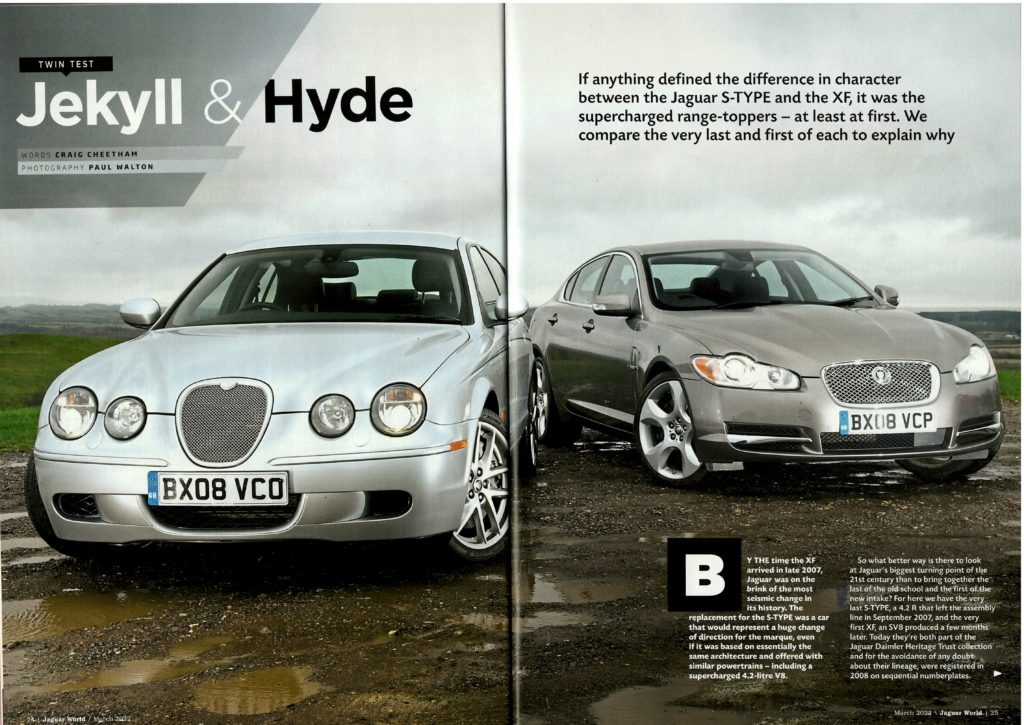
So what better way is there to look at Jaguar’s biggest turning point of the 21st century than to bring together the last of the old school and the first of the new intake? For here we have the very last S-TYPE, a 4.2 R that left the assembly line in September 2007, and the very first XF, an SV8 produced a few months later. Today they’re both part of the Jaguar Daimler Heritage Trust collection and for the avoidance of any doubt about their lineage, were registered in 2008 on sequential numberplates.
Words: Craig Cheetham Photography: Paul Walton
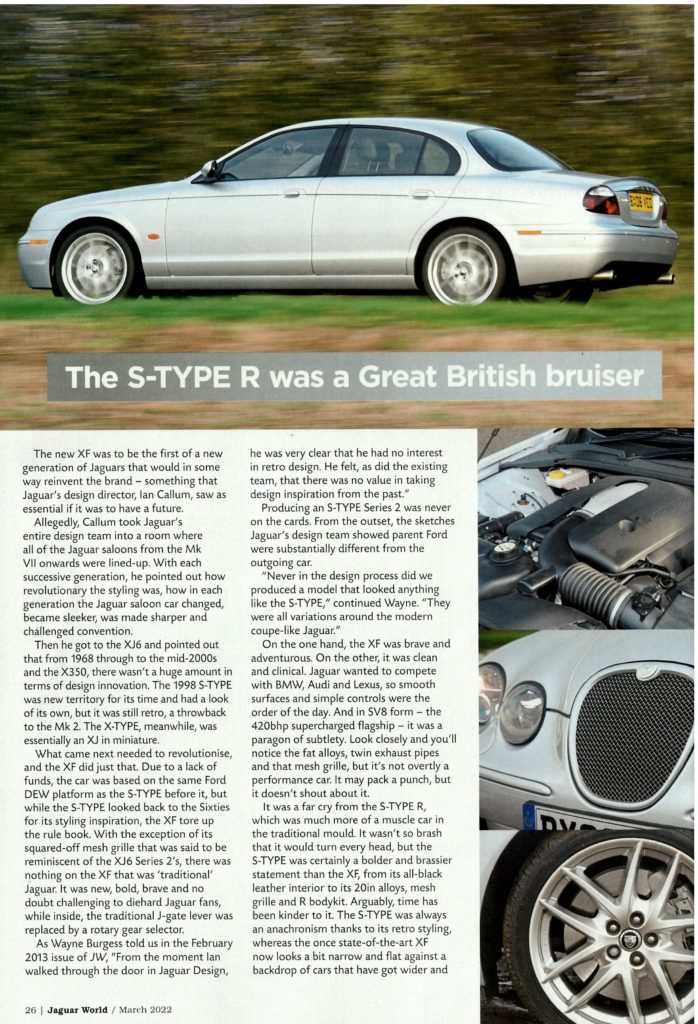
The new XF was to be the first of a new generation of Jaguars that would in some way reinvent the brand – something that Jaguar’s design director Ian Callum, saw as essential if it was to have a future.
Allegedly, Callum took Jaguar’s entire design team into a room where all of the Jaguar saloons from the Mk VII onwards were lined-up. With each successive generation, he pointed out how revolutionary the styling was, how in each generation the Jaguar saloon car changed, became sleeker was made sharper and challenged convention.
Then he got to the XJ6 and pointed out that from 1968 through to the mid-2000s and the X350, there wasn’t a huge amount in terms of design innovation. The 1998 S-TYPE was new territory for its time and had a look of its own, but it was still retro, a throwback to the Mk 2. The X-TYPE, meanwhile, was essentially an XJ in miniature.
What came next needed to revolutionise, and the XF did just that. Due to a lack of funds, the car was based on the same Ford DEW platform as the S-TYPE before it, but while the S-TYPE looked back to the Sixties for its styling inspiration, the XF tore up the rule book. With the exception of its squared-off mesh grille that was said to be reminiscent of the XJ6 Series 2’s, there was nothing on the XF that was ‘traditional’ Jaguar. It was new, bold, brave and no doubt challenging to diehard Jaguar fans, while inside, the traditional J-gate lever was replaced by a rotary gear selector.
As Wayne Burgess told us in the February 2013 issue of JW. “From the moment Ian walked through the door in Jaguar Design, he was very clear that he had no interest in retro design. He felt, as did the existing team, that there was no value in taking design inspiration from the past.”
Producing an S-TYPE Series 2 was never on the cards. From the outset, the sketches Jaguar’s design team showed parent Ford were substantially different from the outgoing car. “Never in the design process did we produced a model that looked anything like the S-TYPE,” continued Wayne. “They were all variations around the modern coupe-like Jaguar.”
On the one hand, the XF was brave and adventurous. On the other, it was clean and clinical. Jaguar wanted to compete with BMW, Audi and Lexus, so smooth surfaces and simple controls were the order of the day. And in SV8 form – the 420 bhp supercharged flagship – it was a paragon of subtlety. Look closely and you’ll notice the fat alloys, twin exhaust pipes and that mesh grille, but it’s not overtly a performance car it may pack a punch, but it doesn’t shout about it.
It was a far cry from the S-TYPE R, which was much more of a muscle car in the traditional mould. It wasn’t so brash that it would turn every head, but the S-TYPE was certainly a bolder and brassier statement than the XF, from its all-black leather interior to its 20in alloys, mesh grille and R bodykit. Arguably, time has been kinder to it, The S-TYPE was always an anachronism thanks to its retro styling, whereas the once state-of-the-art XF now looks a bit narrow and flat against a backdrop of cars that have got wider and taller. It may age more subtly in the future, but the S-TYPE is arguably the better-looking car here.
It’s a different story when it comes to the cabin layouts, though. The XF is a far classier and more upmarket offering that still feels quite fresh today – at the time, it was Jaguar’s biggest leap forward in a generation.
The traditional facets were gone – the slabs of wood, the J-gate gear selector, the analogue instruments, The XF’s cabin was digital and modern, with touchscreens and a simple, uncluttered layout, while the gearlever was replaced by a rotary knob and flappy paddles.
It was an interior that won a number of awards, and with good reason. From the incredible seat comfort to the way the gear selector would rise from the centre console to greet you, it was beautifully thought-out. Even today, it’s a great-looking cabin and doesn’t feel hugely dated.
The S-TYPE does, though. It feels positively antiquated, even with Jaguar’s early 2000s ‘haptic feedback’ touchscreen that was all the rage back at the start of the century. It has all the bells and whistles – climate control, electric seats, auto lights and wipers and a decent stereo, but the layout and packaging feel aeons behind.
By far the most notable difference between these two cars, though, is in the way that they drive. Their characters are completely different.
Even with a tiny mileage – the JDHT’s 1,900-mile example must be one of the very lowest mileage S-TYPES left – the older car feels like it’s a generation behind. That’s astonishing when you consider that they’re both based on the same DEW platform and have a similar footprint, but part of Jaguar’s aim when developing the XF was to benchmark the car against its more modern rivals. and as a result the XF’s steering is much lighter but quicker to respond. It feels lighter even though it isn’t, has a sharper turn-in and is generally a more agile car to drive.
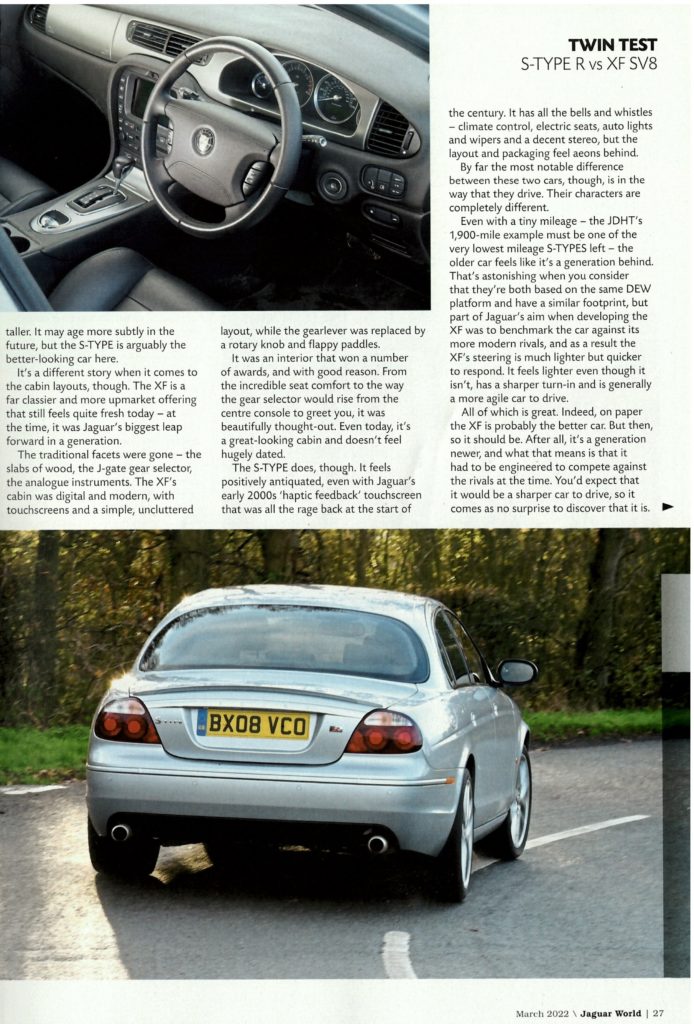
All of which is great. Indeed, on paper the XF is probably the better car. But then, so it should be. After all, it’s a generation newer, and what that means is that it had to be engineered to compete against the rivals at the time. You’d expect that it would be a sharper car to drive, so it comes as no surprise to discover that it is.
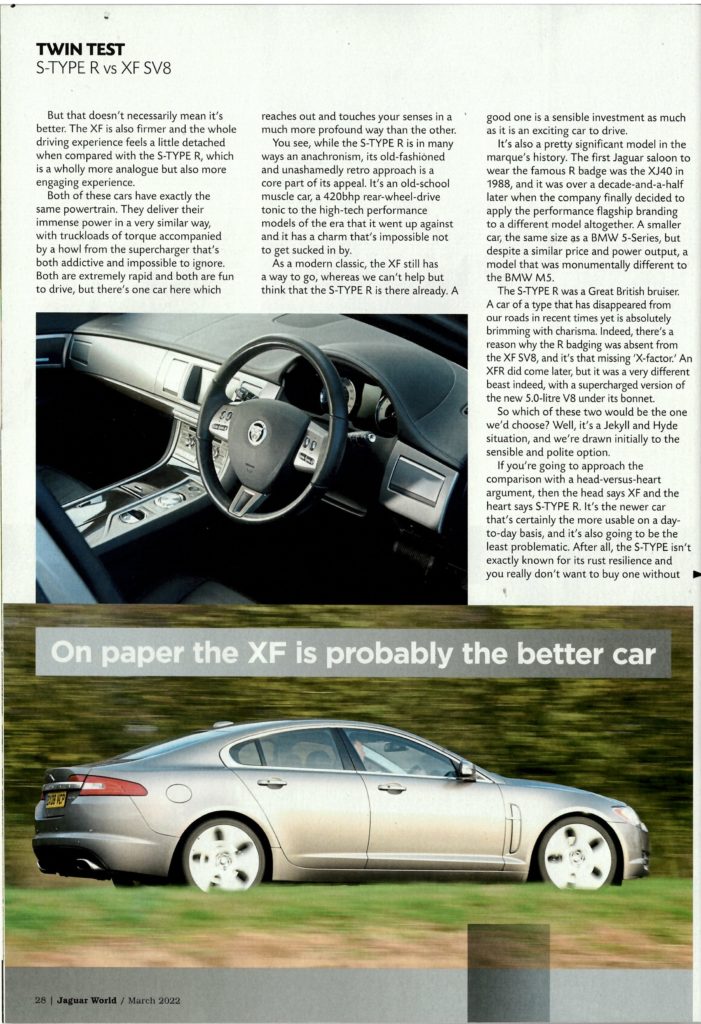
But that doesn’t necessarily mean it’s better. The XF is also firmer and the whole driving experience feels a little detached when compared with the S-TYPE R, which is a wholly more analogue but also more engaging experience.
Both of these cars have exactly the same powertrain. They deliver their immense power in a very similar way, with truckloads of torque accompanied by a howl from the supercharger that’s both addictive and impossible to ignore. Both are extremely rapid and both are fun to drive, but there’s one car here which reaches out and touches your senses in a
much more profound way than the other.
You see, while the S-TYPE R is in many ways an anachronism, its old-fashioned and unashamedly retro approach is a core part of its appeal. It’s an old-school muscle car, a 420 bhp rear-wheel-drive tonic to the high-tech performance models of the era that it went up against and it has a charm that’s impossible not to get sucked in by.
As a modern classic, the XF still has a way to go, whereas we can’t help but think that the S-TYPE R is there already. A good one is a sensible investment as much as it is an exciting car to drive.
It’s also a pretty significant model in the marque’s history. The first Jaguar saloon to wear the famous R badge was the XJ40 in 1988, and it was over a decade-and-a-half later when the company finally decided to apply the performance flagship branding to a different model altogether. A smaller car, the same size as a BMW 5-Series, but despite a similar price and power output, a model that was monumentally different to the BMW M5.
The S-TYPE R was a Great British bruiser. A car of a type that has disappeared from our roads in recent times yet is absolutely brimming with charisma. Indeed, there’s a reason why the R badging was absent from the XF SV8, and it’s that missing ‘X-factor.’ An XFR did come later but it was a very different beast indeed, with a supercharged version of the new 5.0-litre V8 under its bonnet.
So which of these two would be the one we’d choose? Well, it’s a Jekyll and Hyde situation, and we’re drawn initially to the sensible and polite option.
If you’re going to approach the comparison with a head-versus-heart argument, then the head says XF and the heart says S-TYPE R. It’s the newer car that’s certainly the more usable on a day-to-day basis, and it’s also going to be the least problematic. After all, the S-TYPE isn’t exactly known for its rust resilience and you really don’t want to buy one without checking the condition of its sills and underside first. Even then, you’ll probably never truly relax.
As a daily driver then, the XF SV8 is head and shoulders above its predecessor. But that doesn’t make it an outright winner – far from it, in fact. It’s a great car. One of the best Jaguar saloons of the modern era, and it’s also far better made than the S-TYPE.
But when you walk up to both of these cars with a set of keys for each in your pocket, it’s the older car that draws you in. It’s hair-raising, engaging and exciting in a way that the polished edges of the SV8 prevent the newer car from being.
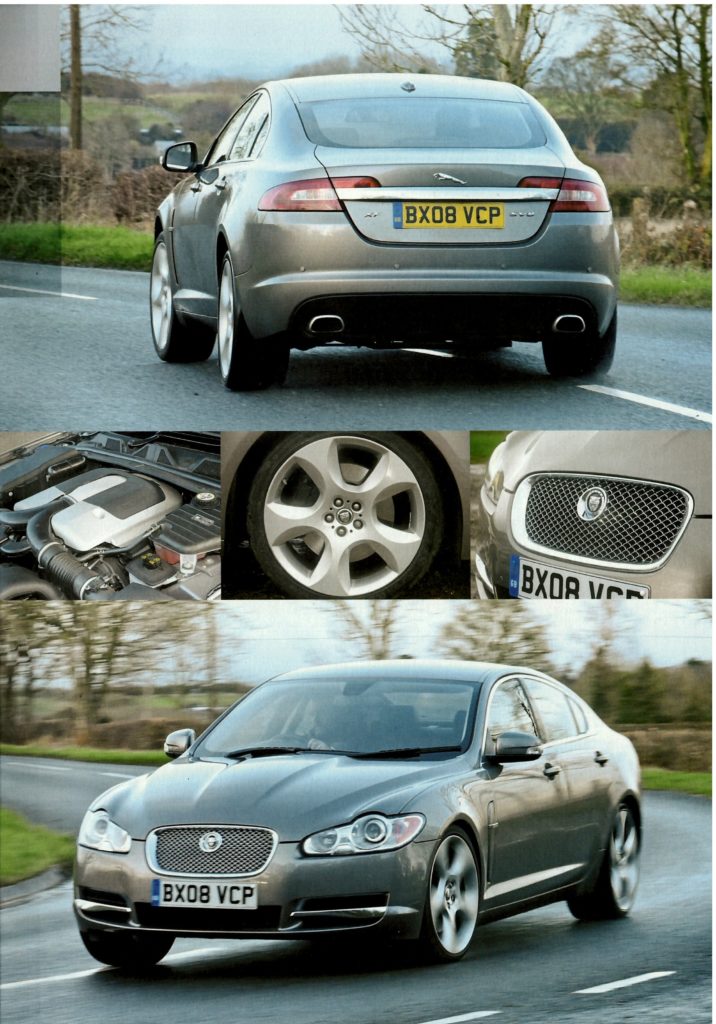
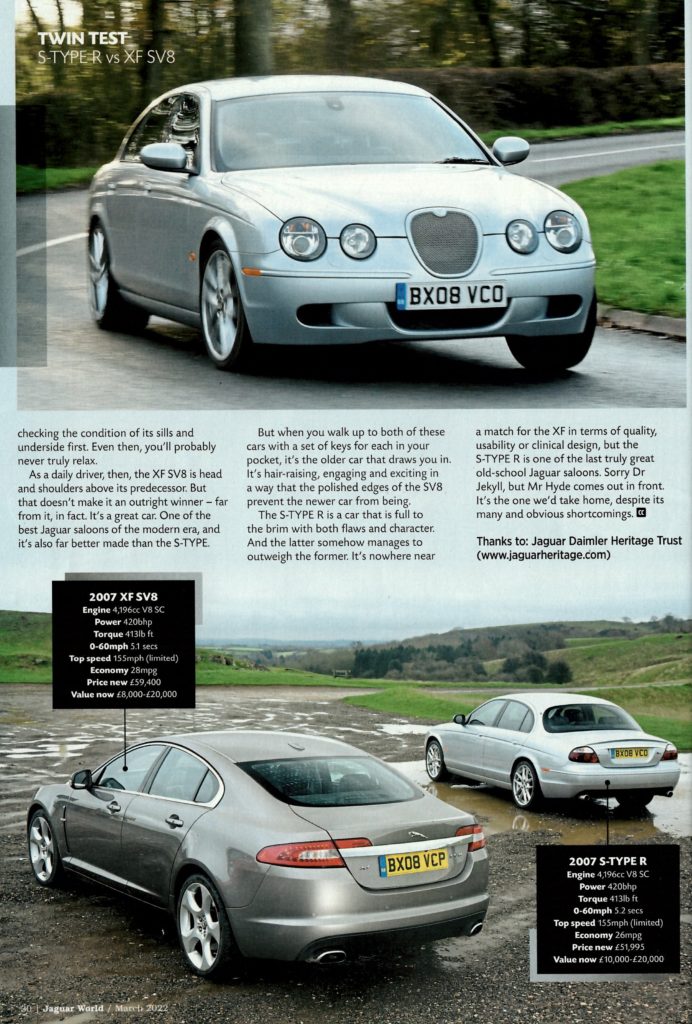
The S-TYPE R is a car that is full to the brim with both flaws and character. And the latter somehow manages to outweigh the former. It’s nowhere near a match for the XF in terms of quality, usability or clinical design, but the S-TYPE R is one of the last truly great old-school Jaguar saloons. Sorry Dr Jekyll, but Mr Hyde comes out in front. It’s the one we’d take home, despite its many and obvious shortcomings.
2007 S-TYPE | 2007 XF SV8 | |
| Engine | 4,196 cc V8 SC | 4,196 cc V8 SC |
| Power | 420 bhp | 420 bhp |
| Torque | 413 lb ft | 413 lb ft |
| 0-60- mph | 5.2 secs | 5.1 secs |
| Top Speed | 155 mph | 155 mph |
| Economy | 26 mpg | 28 mpg |
| Price new | £51,995 | £59,400 |
| Value Now | £10k-20k | £8-20k |
Thanks to: Jaguar Daimler Heritage Trust
(www.jaguarheritage.com)